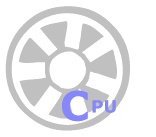|
 CPU's Inside's CPU's Inside's
What's Inside
-On most processors you will find millions of transistors packed unto a square rectangle casing(Socket 7). Some of these casing is made of ceramic material to rid itself of heat better. As talked about in hard drives with platters being made of ceramic materials. Some processors even have silk screening so to etch a serial number on it. This is to try and prevent stealing and so on.
-If you own a Pentium system especially a newer one such as Pentium II, Celeron, and Xeon your processor is a little different. The processor is packed into a black plastic module. This is what is called a SEC (Single Edge Connector) and is good for getting rid of heat and a better connection than the Socket 7. The processor can also pack more circuitry like L2 cache which is superfast memory. This is discussed in the memory section.
-Now that you know that the CPU has a ga-zillion little transistors we need to know what the functions are of the CPU. There are a few and they tie into the motherboard. Some key systems of the processors are the data bus, address bus, primary cache L1, Registers, instruction pipelines, floating point unit, and MMX instructions. All of these come done to performance.
-Data Bus, the data bus is a collection of dedicated circuits and wires that move information in and out of the CPU. Kind of like a highway the bigger the better. Most newer BUS's can handle 64 bit which is 64 wires or lines of communication. The data bus going into the CPU runs faster than when outside the CPU. A good example is the system that I am using right now. My CPU runs at 400 Mhz on the inside and 100 Mhz on the outside. Kinda sucks when it comes downs to it. A good side to this is something called bursting. This will allow information to basically poor into the CPU's cache (memory) in one burst. Keeping the CPU busy and the system running well on less open lines of communication. This will of course improve in the future. AMD is already talking about a external BUS speeds of 200 Mhz and up to 400 Mhz for there new Athlon processors.
-Address Bus, this is as the names suggest. The address bus is a set of wires that allow bits of information with memory addresses for the CPU. This give's the CPU access to information in system memory and the CPU will know where to get it. The bigger the BUS the better, much like the Data Bus. Most processors will want to dedicate more pins of the CPU for the Data BUS rather than Addressing. We want all that data we can get!
-L1 Cache (level 1), The cache is a super fast memory for the CPU and is also located on the motherboard as L2 Cache. The L1 cache is were data will be kept that is most useful to the CPU. The CPU has the job of guessing what you will need next and if it may already be in the L1 cache. Of course when it isn't the CPU has to look elsewhere in the system and may take longer. The more cache on the CPU usually the better performance. Most processors today have 32-64kb of cache. This isn't a terrible amount of memory but is fast. Also cache is expensive and takes up a good bit of room on the processor. We don't want the processor being to big and expensive now do we?
-Floating Point, the main idea of the floating point is its ability to handle complex non-integer numbers. Most floating points sit somewhat dormant and are not used. The use of the floating point comes in when you are using CAD/CAM designs, graphics design, and even Quake II uses it a good bit.
-Instructions, I know we all remember the MMX monster that Intel put out. It was and still is a cool little add on. This is just a set of instructions that was added in for a more multimedia experience. The instructions when introduced in 1997 was a set of 57. Of course as time goes on instructions will get more diverse and more complicated. Other than the MMX is AMD's 3d now which is there version of MMX. This is also an enhancement for 3D applications and games. The idea of any of these instructions is the software made to run under them. The more games that support 3D now the better the AMD will perform vice versa.
 Installing A CPU Installing A CPU
 Back To Hardware Guides Back To Hardware Guides
Popular Articles:
How To Build A PC | Different Types of Keyboards | Help with Hard Drive Installation | Computer Networking Basics | Introduction of Motherboard Functions | Computer CPU Processor Speed | Upgrade from Windows 95 to Windows 98 | Computer Monitor Troubleshoot | Partition Hard Drive | Installing New CPU Processor | Types of Network Cables |